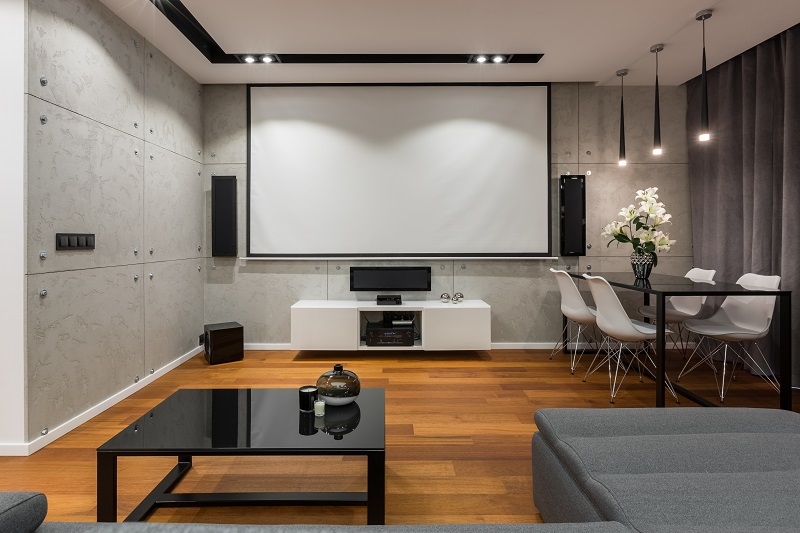
Creating the best in-home viewing scenario in your living room is exciting, especially with the right combination of comfort, look and feel, and technology. However, selecting the right projector for your living room with bright lights can be tougher.
Ambient light can ruin the quality of your image. For example, traditional projectors fall short in a space filled with natural sunlight, providing washed-out images and frustrating viewing experiences. Specifications and features are essential when finding the right projector for a bright room. This guide will review everything you need to know to select the right projector for the bright room environment.
Let’s see what goes into getting the right daylight projector in your living room.
Before we explore the “how,” let's have the "why" conversation. The vast majority of projectors are configured for dark, theater-like environments. When a projector is placed in a living room with significant amounts of daylight streaming during the day or in a room where ambient lighting is regularly utilized, the projector typically results in dull or faded images.
Some of the main reasons why standard projectors fall short excessively include:
To alleviate the issue, your projector search must be directed toward features specifically designed to handle high-light environments.
The following are the key features and specifications to consider when selecting a projector for use in a bright room.
The primary specification for a bright room is the projector's brightness. Brightness is rated in ANSI lumens, and as the number increases, the brightness increases.
A projector with a high lumen rating will allow the projected images to withstand sunlight or ceiling lights, enabling the colors to pop and the details to stand out.
There are three main types of projection technology:
DLP or LCD projectors provide the best balance between brightness/image quality and cost for nearly all ambient light projections.
While brightness is essential, don’t ignore the contrast ratio. This determines how well your projector can display deeper blacks and more dynamic colors.
Depending on your room size, throw distance plays a role:
If you’re projecting from a coffee table or TV stand, a short throw is your best bet.
Let’s categorize your options. Here are the best projector types suited for well-lit environments:
Laser projectors are among the best ambient light projector options thanks to their intense brightness and color accuracy.
Pros:
Cons:
LED projectors offer a mix of decent brightness and energy efficiency.
Pros:
Cons:
For very bright rooms, only high-end LED projectors will suffice.
Traditional lamp-based projectors are standard and bright, requiring regular bulb replacements.
Pros:
Cons:
These are often your go-to high-lumen projector options when on a budget.
Beyond brightness and display technology, several other features can enhance your viewing experience in a bright setting:
This helps correct the image angle and positioning, even with limited space, so you get a properly aligned image.
Modern living room setup projectors often come with Android TV, Roku, or other innovative OS platforms. It means fewer wires and better aesthetics.
High dynamic range ensures better color depth and contrast even in high-light environments.
If you're using the projector for streaming, gaming, or sports, 4K resolution paired with high brightness creates an immersive experience even with sunlight flooding the room.
Your screen plays a significant role in the final visual output. To make the most of your daylight projector, invest in a screen designed to combat ambient light.

These screens reflect light in a focused direction, minimizing washout and maximizing contrast.
Sometimes, it’s not just about the tech—how you set it up. Here's how to create an optimized living room setup for your projector:
Use blackout curtains or shades to reduce excessive sunlight.
Avoid placing the projector directly facing large windows. Angle it or use ceiling mounts for better visuals.
White walls and furniture can reflect excess light and reduce perceived contrast. Use neutral tones around the screen area.
Here are some top-rated models to consider for 2025:
These reliable ambient light projector options deliver intense brightness and color performance.
If you're working with a budget, here's how to maximize your budget:
When selecting a bright living room format projector, there is more to it than choosing a high-quality, high-resolution projector. You need to consider projector brightness, adjacent light sources, display technology, and even the screen you will select. Luckily, today’s technology allows you to have sharp lines and lush colors even during the day at a reasonable price. Whether binge-watching your latest hit series or hosting the weekend sports night, the right daylight projector will convert your living room into a home theater you will not want to leave.
This content was created by AI